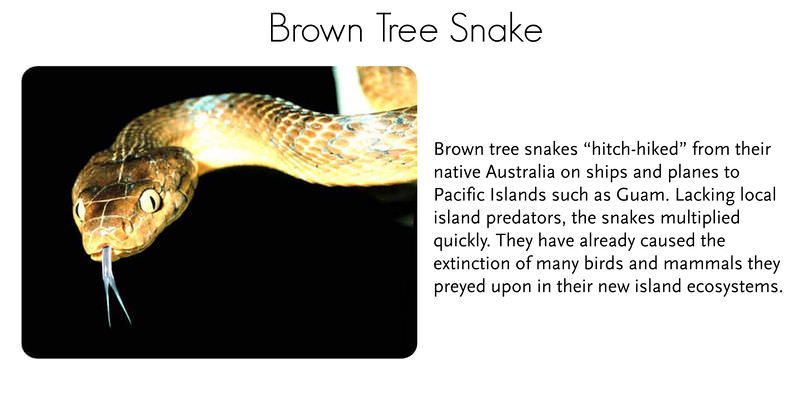6.18: Mass Extinction
- Page ID
- 12145
\( \newcommand{\vecs}[1]{\overset { \scriptstyle \rightharpoonup} {\mathbf{#1}} } \)
\( \newcommand{\vecd}[1]{\overset{-\!-\!\rightharpoonup}{\vphantom{a}\smash {#1}}} \)
\( \newcommand{\dsum}{\displaystyle\sum\limits} \)
\( \newcommand{\dint}{\displaystyle\int\limits} \)
\( \newcommand{\dlim}{\displaystyle\lim\limits} \)
\( \newcommand{\id}{\mathrm{id}}\) \( \newcommand{\Span}{\mathrm{span}}\)
( \newcommand{\kernel}{\mathrm{null}\,}\) \( \newcommand{\range}{\mathrm{range}\,}\)
\( \newcommand{\RealPart}{\mathrm{Re}}\) \( \newcommand{\ImaginaryPart}{\mathrm{Im}}\)
\( \newcommand{\Argument}{\mathrm{Arg}}\) \( \newcommand{\norm}[1]{\| #1 \|}\)
\( \newcommand{\inner}[2]{\langle #1, #2 \rangle}\)
\( \newcommand{\Span}{\mathrm{span}}\)
\( \newcommand{\id}{\mathrm{id}}\)
\( \newcommand{\Span}{\mathrm{span}}\)
\( \newcommand{\kernel}{\mathrm{null}\,}\)
\( \newcommand{\range}{\mathrm{range}\,}\)
\( \newcommand{\RealPart}{\mathrm{Re}}\)
\( \newcommand{\ImaginaryPart}{\mathrm{Im}}\)
\( \newcommand{\Argument}{\mathrm{Arg}}\)
\( \newcommand{\norm}[1]{\| #1 \|}\)
\( \newcommand{\inner}[2]{\langle #1, #2 \rangle}\)
\( \newcommand{\Span}{\mathrm{span}}\) \( \newcommand{\AA}{\unicode[.8,0]{x212B}}\)
\( \newcommand{\vectorA}[1]{\vec{#1}} % arrow\)
\( \newcommand{\vectorAt}[1]{\vec{\text{#1}}} % arrow\)
\( \newcommand{\vectorB}[1]{\overset { \scriptstyle \rightharpoonup} {\mathbf{#1}} } \)
\( \newcommand{\vectorC}[1]{\textbf{#1}} \)
\( \newcommand{\vectorD}[1]{\overrightarrow{#1}} \)
\( \newcommand{\vectorDt}[1]{\overrightarrow{\text{#1}}} \)
\( \newcommand{\vectE}[1]{\overset{-\!-\!\rightharpoonup}{\vphantom{a}\smash{\mathbf {#1}}}} \)
\( \newcommand{\vecs}[1]{\overset { \scriptstyle \rightharpoonup} {\mathbf{#1}} } \)
\( \newcommand{\vecd}[1]{\overset{-\!-\!\rightharpoonup}{\vphantom{a}\smash {#1}}} \)
\(\newcommand{\avec}{\mathbf a}\) \(\newcommand{\bvec}{\mathbf b}\) \(\newcommand{\cvec}{\mathbf c}\) \(\newcommand{\dvec}{\mathbf d}\) \(\newcommand{\dtil}{\widetilde{\mathbf d}}\) \(\newcommand{\evec}{\mathbf e}\) \(\newcommand{\fvec}{\mathbf f}\) \(\newcommand{\nvec}{\mathbf n}\) \(\newcommand{\pvec}{\mathbf p}\) \(\newcommand{\qvec}{\mathbf q}\) \(\newcommand{\svec}{\mathbf s}\) \(\newcommand{\tvec}{\mathbf t}\) \(\newcommand{\uvec}{\mathbf u}\) \(\newcommand{\vvec}{\mathbf v}\) \(\newcommand{\wvec}{\mathbf w}\) \(\newcommand{\xvec}{\mathbf x}\) \(\newcommand{\yvec}{\mathbf y}\) \(\newcommand{\zvec}{\mathbf z}\) \(\newcommand{\rvec}{\mathbf r}\) \(\newcommand{\mvec}{\mathbf m}\) \(\newcommand{\zerovec}{\mathbf 0}\) \(\newcommand{\onevec}{\mathbf 1}\) \(\newcommand{\real}{\mathbb R}\) \(\newcommand{\twovec}[2]{\left[\begin{array}{r}#1 \\ #2 \end{array}\right]}\) \(\newcommand{\ctwovec}[2]{\left[\begin{array}{c}#1 \\ #2 \end{array}\right]}\) \(\newcommand{\threevec}[3]{\left[\begin{array}{r}#1 \\ #2 \\ #3 \end{array}\right]}\) \(\newcommand{\cthreevec}[3]{\left[\begin{array}{c}#1 \\ #2 \\ #3 \end{array}\right]}\) \(\newcommand{\fourvec}[4]{\left[\begin{array}{r}#1 \\ #2 \\ #3 \\ #4 \end{array}\right]}\) \(\newcommand{\cfourvec}[4]{\left[\begin{array}{c}#1 \\ #2 \\ #3 \\ #4 \end{array}\right]}\) \(\newcommand{\fivevec}[5]{\left[\begin{array}{r}#1 \\ #2 \\ #3 \\ #4 \\ #5 \\ \end{array}\right]}\) \(\newcommand{\cfivevec}[5]{\left[\begin{array}{c}#1 \\ #2 \\ #3 \\ #4 \\ #5 \\ \end{array}\right]}\) \(\newcommand{\mattwo}[4]{\left[\begin{array}{rr}#1 \amp #2 \\ #3 \amp #4 \\ \end{array}\right]}\) \(\newcommand{\laspan}[1]{\text{Span}\{#1\}}\) \(\newcommand{\bcal}{\cal B}\) \(\newcommand{\ccal}{\cal C}\) \(\newcommand{\scal}{\cal S}\) \(\newcommand{\wcal}{\cal W}\) \(\newcommand{\ecal}{\cal E}\) \(\newcommand{\coords}[2]{\left\{#1\right\}_{#2}}\) \(\newcommand{\gray}[1]{\color{gray}{#1}}\) \(\newcommand{\lgray}[1]{\color{lightgray}{#1}}\) \(\newcommand{\rank}{\operatorname{rank}}\) \(\newcommand{\row}{\text{Row}}\) \(\newcommand{\col}{\text{Col}}\) \(\renewcommand{\row}{\text{Row}}\) \(\newcommand{\nul}{\text{Nul}}\) \(\newcommand{\var}{\text{Var}}\) \(\newcommand{\corr}{\text{corr}}\) \(\newcommand{\len}[1]{\left|#1\right|}\) \(\newcommand{\bbar}{\overline{\bvec}}\) \(\newcommand{\bhat}{\widehat{\bvec}}\) \(\newcommand{\bperp}{\bvec^\perp}\) \(\newcommand{\xhat}{\widehat{\xvec}}\) \(\newcommand{\vhat}{\widehat{\vvec}}\) \(\newcommand{\uhat}{\widehat{\uvec}}\) \(\newcommand{\what}{\widehat{\wvec}}\) \(\newcommand{\Sighat}{\widehat{\Sigma}}\) \(\newcommand{\lt}{<}\) \(\newcommand{\gt}{>}\) \(\newcommand{\amp}{&}\) \(\definecolor{fillinmathshade}{gray}{0.9}\)
This is one of the most powerful birds in the world. Could it go extinct?
The Philippine Eagle, also known as the Monkey-eating Eagle, is among the rarest, largest, and most powerful birds in the world. It is critically endangered, mainly due to massive loss of habitat due to deforestation in most of its range. Killing a Philippine Eagle is punishable under Philippine law by twelve years in jail and heavy fines.
Human Actions and the Sixth Mass Extinction
Over 99 percent of all species that ever lived on Earth have gone extinct. Five mass extinctions are recorded in the fossil record. They were caused by major geologic and climatic events. Evidence shows that a sixth mass extinction is occurring now. Unlike previous mass extinctions, the sixth extinction is due to human actions.
Some scientists consider the sixth extinction to have begun with early hominids during the Pleistocene. They are blamed for over-killing big mammals such as mammoths. Since then, human actions have had an ever greater impact on other species. The present rate of extinction is between 100 and 100,000 species per year. In 100 years, we could lose more than half of Earth’s remaining species.
Causes of Extinction
The single biggest cause of extinction today is habitat loss. Agriculture, forestry, mining, and urbanization have disturbed or destroyed more than half of Earth’s land area. In the U.S., for example, more than 99 percent of tall-grass prairies have been lost. Other causes of extinction today include:
- Exotic species introduced by humans into new habitats. They may carry disease, prey on native species, and disrupt food webs. Often, they can out-compete native species because they lack local predators. An example is described in Figure below.
- Over-harvesting of fish, trees, and other organisms. This threatens their survival and the survival of species that depend on them.
- Global climate change, largely due to the burning of fossil fuels. This is raising Earth’s air and ocean temperatures. It is also raising sea levels. These changes threaten many species.
- Pollution, which adds chemicals, heat, and noise to the environment beyond its capacity to absorb them. This causes widespread harm to organisms.
- Human overpopulation, which is crowding out other species. It also makes all the other causes of extinction worse.
 The brown tree snake is an exotic species that has caused many extinctions on Pacific islands such as Guam.
The brown tree snake is an exotic species that has caused many extinctions on Pacific islands such as Guam.Effects of Extinction
The results of a study released in the summer of 2011 have shown that the decline in the numbers of large predators like sharks, lions and wolves is disrupting Earth's ecosystem in all kinds of unusual ways. The study, conducted by scientists from 22 different institutions in six countries, confirmed the sixth mass extinction. The study states that this mass extinction differs from previous ones because it is entirely driven by human activity through changes in land use, climate, pollution, hunting, fishing and poaching. The effects of the loss of these large predators can be seen in the oceans and on land.
- Fewer cougars in the western US state of Utah led to an explosion of the deer population. The deer ate more vegetation, which altered the path of local streams and lowered overall biodiversity.
- In Africa, where lions and leopards are being lost to poachers, there is a surge in the number of olive baboons, who are transferring intestinal parasites to humans living nearby.
- In the oceans, industrial whaling led a change in the diets of killer whales, who eat more sea lions, seals, and otters and have dramatically lowered the population counts of those species.
The study concludes that the loss of big predators has likely driven many of the pandemics, population collapses and ecosystem shifts the Earth has seen in recent centuries.
Disappearing Frogs
Around the world, frogs are declining at an alarming rate due to threats like pollution, disease, and climate change. Frogs bridge the gap between water and land habitats, making them the first indicators of ecosystem changes.
Nonnative Species
Scoop a handful of critters out of the San Francisco Bay and you'll find many organisms from far away shores. Invasive kinds of mussels, fish, and more are choking out native species, challenging experts around the state to change the human behavior that brings them here.
How You Can Help Protect Biodiversity
There are many steps you can take to help protect biodiversity. For example:
- Consume wisely. Reduce your consumption wherever possible. Re-use or recycle rather than throw out and buy new. When you do buy new, choose products that are energy efficient and durable.
- Avoid plastics. Plastics are made from petroleum and produce toxic waste.
- Go organic. Organically grown food is better for your health. It also protects the environment from pesticides and excessive nutrients in fertilizers.
- Save energy. Unplug electronic equipment and turn off lights when not in use. Take mass transit instead of driving.
Lost Salmon
Why is the salmon population of Northern California so important? Salmon do not only provide food for humans, but also supply necessary nutrients for their ecosystems. Because of a sharp decline in their numbers, in part due to human interference, the entire salmon fishing season off California and Oregon was canceled in both 2008 and 2009. The species in the most danger of extinction is the California coho salmon.
Summary
- Evidence shows that a sixth mass extinction is occurring. The single biggest cause is habitat loss caused by human actions.
- There are many steps you can take to help protect biodiversity. For example, you can use less energy.
Review
- How is human overpopulation related to the sixth mass extinction?
- Why might the brown tree snake or the Philippine Eagle serve as “poster species” for causes of the sixth mass extinction?
- Describe a hypothetical example showing how rising sea levels due to global warming might cause extinction.
- Create a poster that conveys simple tips for protecting biodiversity.
Resources
| Image | Reference | Attributions |
 |
[Figure 1] | Credit: National Park Service Source: commons.wikimedia.org/wiki/File:Brown_tree_snake_Boiga_irregularis_2_USGS_Photograph.jpg ; https://www.flickr.com/photos/wanderingseoul61/1503897694/in/photolist-3hTSoA-7x5ZxA-9Dvc1e-ph1dwn-74oBbv-fpLRzV-a16W4D-tdfXGw-p56eYi-jARvmo-HH38a-6S8Xdn-p5FcdJ-5Y1mxr-6mvhzP-fqjAPz-jEuSET-9futhb-6mzsgN-6mzrEb-6mvgUH-6mzpHf-6mzp4C-7eEmr1-8WXynB-8X1zb7-qNsmVr-8PJopF-8DNGbR-7Pv1sV-8vtfL9-3qaAqq-94f7sQ-9ww1cx-9ZKqjM-8QT5i7-aGXVj6-8SzxVu-jEu3Nn-9ah1WH-DYcJB-9f18hz-7ehNNi-9iA9HM-78U7Ru-3qaARy-kGnUpR-5Q7pL8-5RCgGX-9V2J3X License: Public Domain |
 |
[Figure 2] | Credit: National Park Service Source: commons.wikimedia.org/wiki/File:Brown_tree_snake_Boiga_irregularis_2_USGS_Photograph.jpg License: Public Domain |

